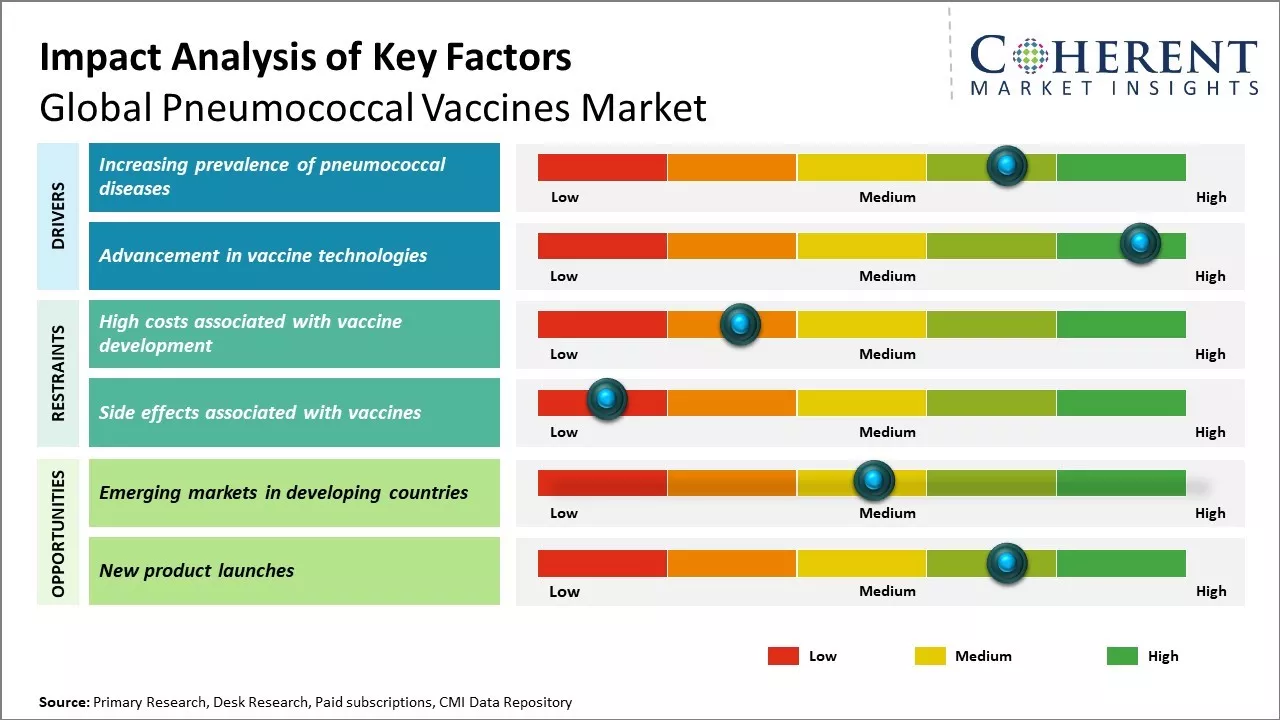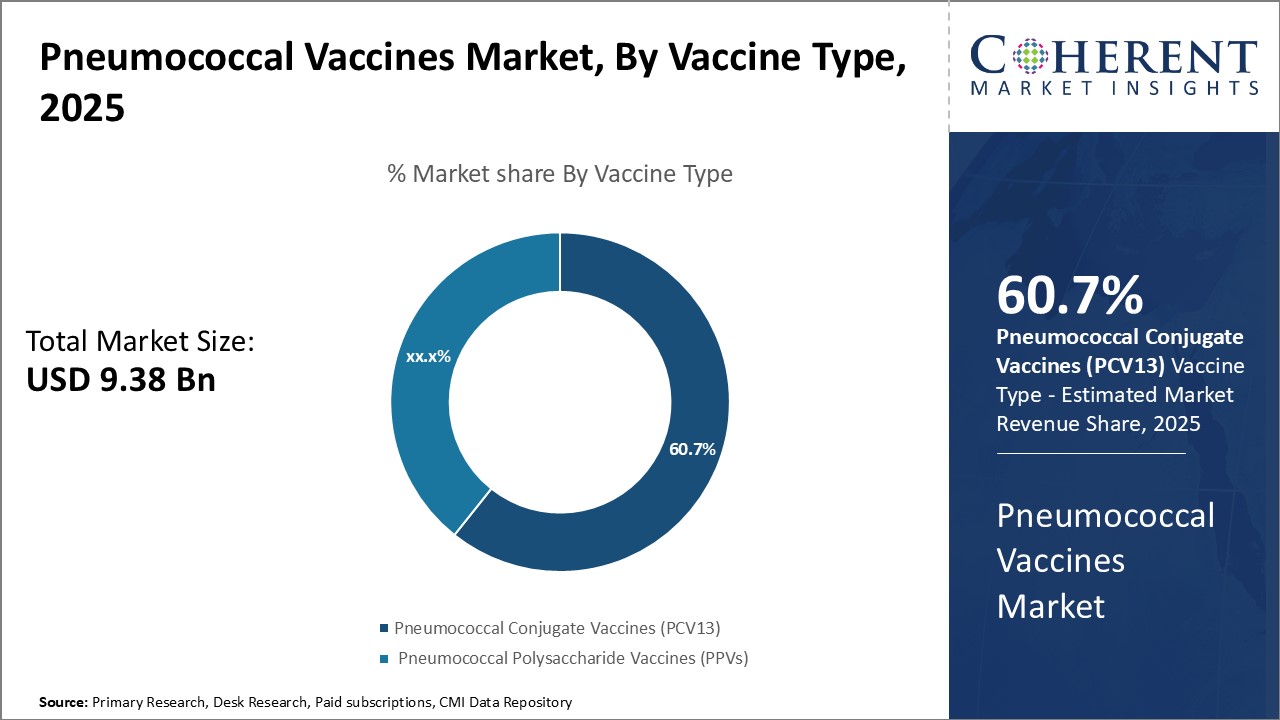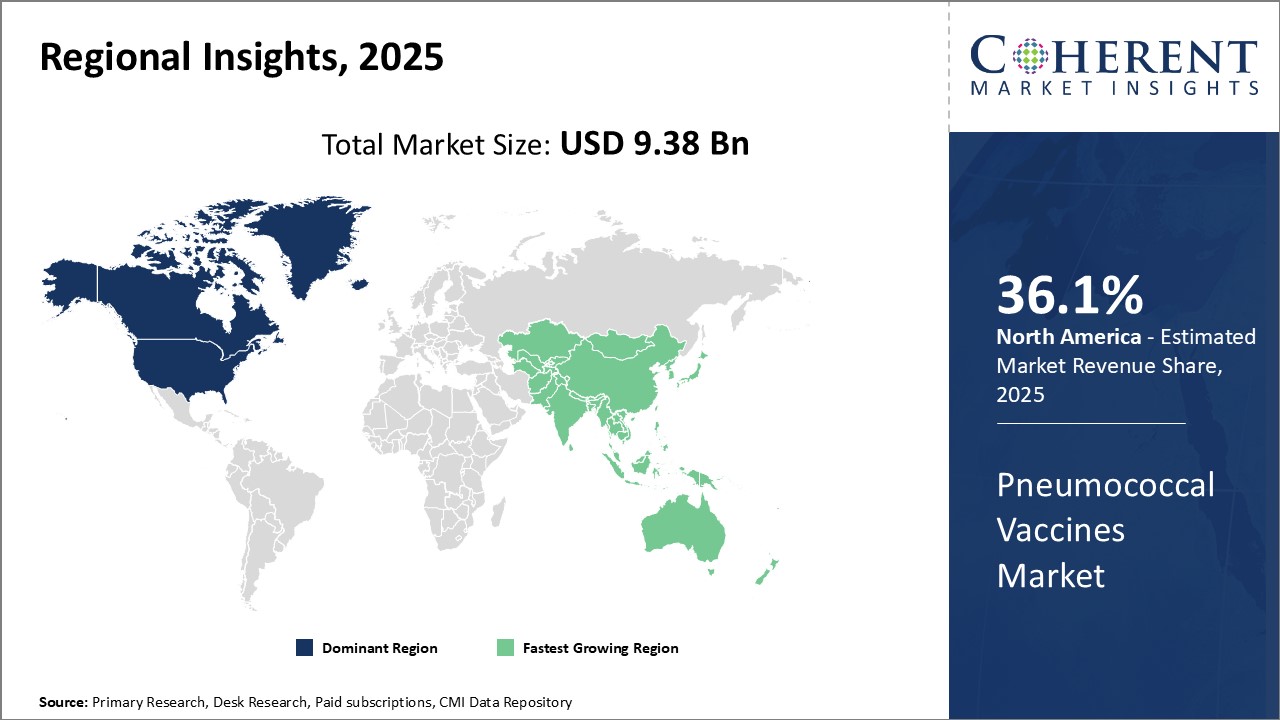Global pneumococcal vaccines market is estimated to be valued at USD 9.38 billion in 2025 and is expected to reach USD 13.29 billion by 2032, exhibiting a compound annual growth rate (CAGR) of 5.1% from 2025 to 2032. Increasing awareness about prevention of pneumococcal disease can boost demand for effective vaccination. The market growth is driven by expansion of immunization programs worldwide and introduction of newer and advanced vaccines to tackle serotype replacement concerns.

Discover market dynamics shaping the industry: Request sample copy
Market Driver - Increasing prevalence of pneumococcal diseases
Rising burden of pneumococcal diseases can drive the market growth. Streptococcus pneumoniae, also known as pneumococcus, is a major cause of morbidity and mortality worldwide. It is a leading cause of community-acquired pneumonia as well as other infections such as bacteremia, sepsis and meningitis, especially in children and the elderly population. Pneumonia is a significant cause of death among children under 5 years of age. According to the data published by WHO, pneumonia caused over 800,000 deaths in children under age of 5 years in 2019. Although vaccines are available to prevent pneumococcal diseases, it is still endemic in many developing and underdeveloped regions with inadequate access to vaccination and healthcare services. Even in developed nations, growing elderly population who are more vulnerable is becoming a key concern area. With aging population worldwide, the susceptibility to pneumococcal infections is projected to increase in the near future. This, coupled with emergence of antibiotic-resistant strains, has heightened the risks from these preventable diseases. Rising awareness about pneumococcal diseases and their prevention through vaccination programs boosts the need for effective pneumococcal vaccines across all regions. Growing threat posed by these infections warrants strengthened immunization efforts and availability of advanced generation vaccines to counter the global burden of pneumococcal diseases.

Get actionable strategies to beat competition: Request sample copy
Advancement in vaccine technologies
Vaccine technology has witnessed tremendous progress, with new approaches enabling development of more targeted and effective vaccines. Major advancements like conjugate vaccines that stimulate improved immune response and provide longer lasting immunity have revolutionized immunization against pneumococcal diseases. Advancements like cell-culture and protein-based vaccine production platforms offer scalability and efficiency benefits over traditional cultured methods. These innovative technologies facilitate development of next generation pneumococcal vaccine formulations with broader serotype coverage and better immunogenicity. For example, second generation pneumococcal conjugate vaccines now provide protection against over 80% of disease-causing serotypes globally as compared to less than 30% coverage of earlier vaccines. Continued R&D can expand serotype coverage and improve other attributes such as thermostability and one-dose convenience. Novel platform technologies such as protein subunit vaccines also promise better safety by avoiding live pathogens. Driven by the need for universal vaccines, new mechanisms involving polypeptide constructs and glyco-engineering are being actively pursued. With escalating antibiotic resistance challenge, vaccine innovation is increasingly being relied upon for long-term pneumococcal disease control. This augurs well for next generation pneumococcal vaccine products with capabilities beyond serotype replacement, offering even more comprehensive protection through novel mechanisms of action.
Key Takeaways from Analyst:
Global pneumococcal vaccines market growth is driven by factors like increasing government focus on immunization programs globally and rising awareness about pneumococcal diseases. High prevalence of invasive pneumococcal diseases and inclusion of pneumococcal vaccines in national immunization programs of many countries can boost revenues for vaccine manufacturers. The market has huge potential in developing Asian and African countries where immunization rates are lower than global average. However, high costs of pneumococcal vaccines can hamper their widespread adoption in low and middle-income countries. Vaccine price and affordability can also hamper the market growth. Furthermore, the availability of generic versions once patents expire can pose pricing pressure on innovator brands. The market also faces challenges due to low respiratory disease diagnosis rates in developing regions.The market provides opportunities for manufacturers to expand into lower-income regions through innovative pricing strategies and partnerships with public health organizations. New product additions targeting more pneumococcal serotypes can also boost uptake. North America dominates the market due to extensive vaccination programs and higher per capita healthcare spending. Asia Pacific is poised to be the fastest-growing region due to improving access and economic growth.
Challenge- High Costs Associated with Vaccine Development
Global pneumococcal vaccines market growth can be hampered by high costs associated with vaccine development. Developing a new vaccine is an expensive process that can cost hundreds of millions of dollars. It involves extensive research and clinical trials to prove a vaccine's safety and efficacy. Vaccine manufacturers must navigate a complex regulatory landscape in different countries around the world to get approvals. The development timeline from research to market launch usually spans over a decade. These factors result in huge capital investments that must be recouped through vaccine sales. However, pricing pressures from governments and hospitals seeking affordable vaccines make it difficult for companies to recover their development costs fully. The high entry barriers due to financial requirements may discourage new players from entering this market. To address this challenge, partnerships between private companies and public health organizations can help share the financial burden of research and development.
Opportunity- Emerging Markets in Developing Countries
There presents a major opportunity for growth in the emerging markets of developing countries for pneumococcal vaccines. Pneumonia is a leading killer of children under age of 5 years in many low and middle-income nations. However, vaccination rates remain low currently due to the high cost of existing vaccines and lack of widespread availability. As economies grow and living standards improve in developing regions like Asia Pacific, Latin America and Africa, more people will be able to afford vaccinating their kids. Countries are also focusing on expanding immunization coverage as part of their national healthcare goals. This growing demand, coupled with initiatives to make vaccines more affordable through subsidies and funding from global health organizations, can offer opportunities for manufacturers to tap new customer bases in emerging markets. Vaccine prices tailored for price-sensitive developing world markets and innovative partnerships for local production and distribution can help address major expansion in these regions.

Discover high revenue pocket segments and roadmap to it: Request sample copy
By Vaccine Type- Patient Awareness Boosts Demand for Advanced Pneumococcal Conjugate Vaccines
In terms of vaccine type, pneumococcal conjugate vaccines (PCVs) segment is estimated to contribute the highest market share of 60.7% in 2025, owing to growing patient awareness about its advantages over pneumococcal polysaccharide vaccines (PPVs). PCVs produce stronger and longer lasting immunity by stimulating both humoral and cell mediated immune responses in patients. These are also effective from a younger age, even for high-risk groups like immuno-compromised individuals, and offer cross protection against additional serotypes. The use of PCVs has led to significant reductions in rates of invasive pneumococcal disease (IPD) globally among both vaccinated and unvaccinated populations through herd protection. Among individual vaccines, PCV13 (Prevnar 13/Prevenar 13) witness highest sales, owing to its expanded coverage of 13 pneumococcal serotypes compared to earlier versions like PCV7 and PCV10. Rising medical education about these clinical advantages aid physicians in recommending PCVs over PPVs, especially for pediatric immunization programs, can offer greater disease control and protection amongst populations.
By Target Population- Healthcare Reforms Prioritize Adult Immunization
In terms of route of administration, adults (≥ 65 years) segment is estimated to contribute the highest market share of 43.5% in 2025, due to growing focus of healthcare policies on preventing pneumococcal infections amongst vulnerable elderly individuals. Developed regions like North America and Europe with significant aging populations are prioritizing adult pneumococcal immunization through recommendations and reimbursement coverage. Public programs are providing free or low cost PCV and PPV vaccination for older citizens. Furthermore, higher fatality risk of IPD in elderly encourages families to willingly adhere to adult immunization advice. Healthcare systems also recognize the ability of vaccines to avert future expensive IPD treatment costs. Such policy reforms and health economic factors boosts uptake of pneumococcal shots for people 65 years and above globally.
By Route of Administration- Hospital Pharmacies Lead Due to Its Efficacy and Safety
In terms of distribution channel, hospital pharmacies segment is estimated to contribute the highest market share of 60.5% in 2025, due to the preference of medical practitioners and patients to obtain pneumococcal vaccines from hospital settings rather than retail pharmacies or online channels. Hospitals pharmacies leverage their credentialed staff, standardized processes and accessibility within medical establishments to ensure high quality supply, storage, reconstitution and administration of vaccines. As pneumococcal shots require expertise in handling and meeting guidelines for temperature storage, hospitals are viewed as more reliable by healthcare providers for pneumococcal vaccine stocking and distribution. Furthermore, regulated hospital environment helps alleviate public concerns around safety, side effects and safety traceability that individuals may have when procuring such medical products from other channels without direct medical supervision. Therefore, hospital pharmacies lead pneumococcal vaccine distribution due to their specialized manpower, protocols and integrated care facilities.

Need a Different Region or Segment? Customize now
North America is expected to dominate the pneumococcal vaccines market globally with an estimated market share of 36.1% in 2025. Being one of the early adopters of pneumococcal vaccines, the U.S. accounts for the bulk of demand. With robust healthcare expenditures and universal immunization programs for children, pneumococcal vaccination rates are quite high in the region. Major pharmaceutical companies have established strong production and distribution networks in the country to cater to the needs of the market.
Asia Pacific region is poised to be the fastest growing market for pneumococcal vaccines. While overall immunization rates are improving across most Asian countries, increasing healthcare access and spending can drive the market growth. Countries like China and India with their huge population base and growing middle class offer immense business opportunities. Many local pharmaceutical manufacturers are also actively partnering with international vaccine majors to gain approvals and supply pneumococcal vaccines in this region.
Rising awareness among parents about pneumococcal disease prevention boosts demand in Asian countries. Public as well as private healthcare providers are making concerted efforts to promote vaccination of at-risk groups. This along with supportive governmental policies bodes well for the continued growth momentum of pneumococcal vaccines market in Asia Pacific region. Rapid urbanization and economic development will further aid the Asia Pacific market's ability to emerge as a frontrunner for pneumococcal vaccine suppliers.
Pneumococcal Vaccines Market Report Coverage
| Report Coverage | Details | ||
|---|---|---|---|
| Base Year: | 2024 | Market Size in 2025: | USD 9.38 Bn |
| Historical Data for: | 2020 To 2024 | Forecast Period: | 2025 To 2032 |
| Forecast Period 2025 to 2032 CAGR: | 5.1% | 2032 Value Projection: | USD 13.29 Bn |
| Geographies covered: |
|
||
| Segments covered: |
|
||
| Companies covered: |
Pfizer Inc., Merck & Co., Inc., GlaxoSmithKline plc (GSK), Sanofi, CSL Limited, Serum Institute of India Pvt. Ltd., Vaxcyte, Inc., Astellas Pharma Inc., Panacea Biotec Ltd., Walvax Biotechnology Co., Ltd., Beijing Minhai Biotechnology Co., Ltd., Merck KGaA, Takeda Pharmaceutical Company Limited, AbbVie Inc., Novartis AG, Johnson & Johnson, Biovac, Bharat Biotech, Inovio Pharmaceuticals, Inc., Hilleman Laboratories Pvt. Ltd |
||
| Growth Drivers: |
|
||
| Restraints & Challenges: |
|
||
Uncover macros and micros vetted on 75+ parameters: Get instant access to report
*Definition: Global Pneumococcal Vaccines Market includes a range of vaccines designed to prevent infections caused by Streptococcus pneumoniae, commonly known as pneumococcus. This market features both polysaccharide and conjugate vaccines, which are typically administered via intramuscular injections to children and the elderly. Leading manufacturers provide various vaccines that offer protection against some or all of the more than 90 known pneumococcal serotypes associated with severe illnesses such as pneumonia, bacteremia, and meningitis.
Share
Share
About Author
Abhijeet Kale is a results-driven management consultant with five years of specialized experience in the biotech and clinical diagnostics sectors. With a strong background in scientific research and business strategy, Abhijeet helps organizations identify potential revenue pockets, and in turn helping clients with market entry strategies. He assists clients in developing robust strategies for navigating FDA and EMA requirements.
Missing comfort of reading report in your local language? Find your preferred language :
Transform your Strategy with Exclusive Trending Reports :
Frequently Asked Questions
Joining thousands of companies around the world committed to making the Excellent Business Solutions.
View All Our Clients
US Reciprocal Tax Impact Analysis On Pneumococcal Vaccines Market
Stay updated on tariff changes with expert insights and timely information